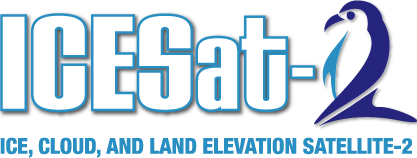
NASA Tests ICESat-2’s Laser Aim
Close enough doesn’t cut it in the spacecraft assembly cleanroom at NASA Goddard’s Space Flight Center, where engineers are building an elevation-measuring instrument to fly on the Ice, Cloud and land Elevation Satellite-2 or ICESat-2. Recently, engineers tested the instrument's pinpoint accuracy.
The instrument, called the Advanced Topographic Laser Altimeter System (ATLAS), will send laser pulses to the ground 300 miles below and then catch the handful of photons that bounce off the surface and return to its telescope mirror. There’s very little margin for error when it comes to individual photons hitting on individual fiber optics – so this November, engineers conducted a series of tests on the ground, to ensure that they could hit that mark when ICESat-2 is in orbit.
"It’s like keeping the point of a pin in line with the head of a pin – only it’s much smaller than that," said Jim Buchheit, ATLAS team lead for the Alignment Monitoring and Control System (AMCS), at NASA Goddard. The AMCS is the collection of optic and electronic equipment that makes sure the laser and telescope are lined up.
ATLAS will take height measurements as the satellite orbits, so scientists can monitor sea ice, land ice, forests, oceans and more. To do this, the instrument is made up of about two dozen different components. Several of these are involved in getting the beam of green light from the laser generating box, through steps that make it the right size and frequency, and splitting it up into six beams. The Alignment Monitoring and Control System and other components are designed to make sure those laser beams are pointing at the same spot on the ground as the receiver telescope – so the receiver can pick up the photons that return.
To do that, after the instrument endures the violent vibration of launch, and as temperatures cause slight warps as ICESat-2 orbits in and out of the sunlight, the ATLAS engineers have built in an automatic steering mechanism for the laser. It moves the six beams as one, to ensure the photons that bounce off Earth are aimed right at the receiver.
"The receiver is looking at six spots on Earth, and we need to illuminate those six spots – and not some other six spots – with the laser beam," said Anthony Martino, ATLAS instrument scientist at Goddard. "We put the control on the laser transmit side. The catcher is standing still, and the pitcher is trying to hit his glove – not the other way around."
In this case, the glove is ATLAS’s 3-foot-wide beryllium telescope. Returning light photons hit the large primary mirror, which is curved to bounce them off a secondary mirror and back into the receiver components sitting behind the telescope. The laser photons from the six laser beams– the handful that return – hit six 300-micron-wide optical fibers attached to the focal plane. The photons pass through filters (to weed out other light frequencies from natural reflected sunlight), and hit the detectors – generating an electrical signal that tells the instrument a photon has returned.
The six fibers catching the photons aren’t the only optical fibers on the receiver focal plane, however. There are also four optical fibers that send out Light Emitting Diode (LED) light, which is a key part of making sure the laser beams and the telescope are aligned. On the ground, each laser beam covers a 40-foot (12-meter) diameter footprint – which has to fit into the receiver’s corresponding 140-foot (43-meter) diameter field of view.
These four LED lights tell the instrument where the telescope itself is pointing. They reflect back into a camera – which is simultaneously receiving a fraction of the six laser beams that were just sent to Earth. By comparing the pattern of four LED spots from the receiver, with the pattern of six laser spots from the beams, the instrument can determine whether the two are properly aligned.
"We know what it should be – and if it’s not that, we change the setting on the beam steering mechanism to move it," Martino said. "That’s done onboard [the instrument], updating about 10 times a second."
The software aboard ATLAS is constantly checking and adjusting the steering, said Alan Gostin, AMCS algorithm design lead for ICESat-2 at Goddard. And the changes it makes are tiny – ATLAS could steer its laser to illuminate the head of a tack that is 100 yards away.
This is the first time Goddard has built an automatically correcting and steering mechanism like this for flight. It was necessary for ATLAS, however, because both the receiver’s field-of-view and the laser beam diameter are significantly smaller than on previous instruments, so there is less room for the laser to drift off-target. So the AMCS team spent several weeks in November 2015 testing the steering mechanism and the software that controls it.
"We’ve been proving our system, tuning the control system that points the laser, to make sure that the laser energy falls on the receiver and we can get the science data back," Buchheit said.
The team set up a system of mirrors to reflect the laser light back into the instrument, to see how the instrument responds. They intentionally moved the beam, then scanned around to see if the instrument could find it and align it to the mirror – a high-tech game of hide-and-seek.
"It simulates what’s going to happen in orbit," Buchheit said. "The return beam is going to move around, and the instrument has to perceive that motion."
These tests are also a rehearsal for what the team will do after the satellite launches, when they’ll run the system through a series of maneuvers to find the perfect laser aim.
"The laser outputs a trillion times more light than is coming back," Gostin said. "But we can see it."

